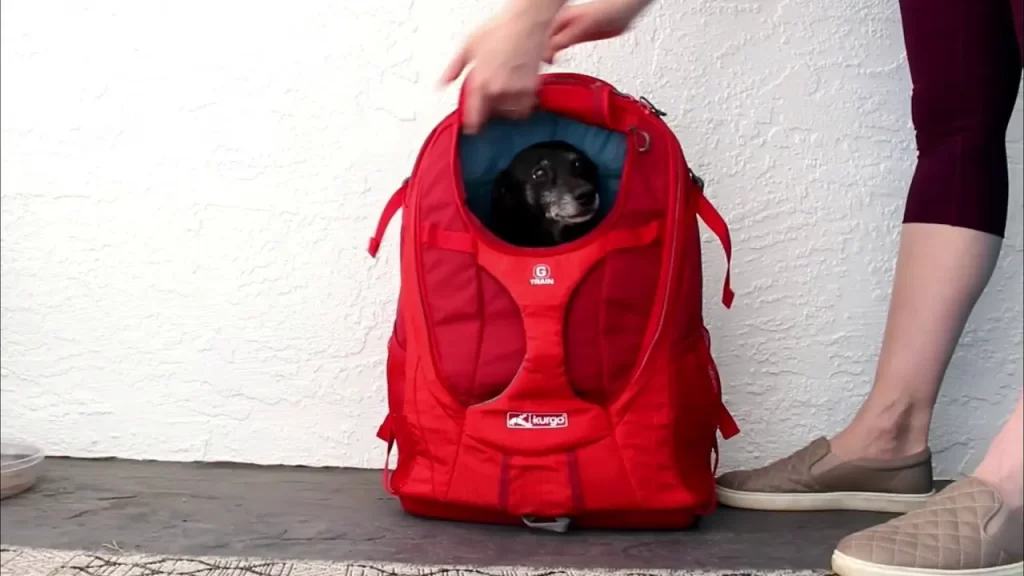
Are dog carrier backpacks safe?
Dog backpacks carrier are an everyday necessity, and worth the investment for your pup to keep them safe.
Make sure to choose one that has features like a waterproof outer layer, a zipper, and a handle.
Here are a few facts about dog backpack carriers before we lean more on the pros and cons.
A backpack carrier for your pet is a case that can encompass their whole body and keeps them at a comfortable temperature when worn by your pet.
It can also be environmentally friendly as there is no great use of plastic or other materials to produce them
They come in different shapes and most are designed to be collapsible so your pet will not have to carry the weight. They make for efficient travel for your pooch.
5 Reasons Why Dog Backpack Are Safe
- Dog carriers help your pet stay safe on the go!
- Popular amongst dog owners, it is a must-have for pets with low stamina and are unable to make one short journey like they used to.
- Dog carriers keep your dogs safe when your traveling or visiting a new area.
- Now you can take your dog out for a walk without having to worry about picking him up from the car or house. Your pet will still be within arms’ reach and give you some needed air & exercise in the process.
- They help you get things done while you focus on what needs your attention.
Is it ok to carry a dog in a baby carrier?
Many people might wonder if it is ok to carry a dog in a baby carrier. They may also worry about the safety of the dog and their child. This article will provide some answers to these questions.
The first thing to consider is the size of your dog. If your pet is small, then it should be okay for you to carry them in a carrier as long as they are not too heavy.
If your pet is large, then you should avoid carrying them in a carrier because they may be uncomfortable or even cause harm to your child.
If you have any concerns about carrying your dog in a carrier, then talk with your vet before doing so.
What’s the best way to carry a dog?
For people who have dogs, the question on how to carry them is a common one.
For those who don’t have dogs or don’t know much about them, it’s also a question that comes up from time to time.
There are many different ways to carry your dog. Some people prefer to carry their dogs in a backpack while others prefer carrying them in a carrier bag or sling bag. There are also some people who use strollers for transporting their dogs.
The best way to carry your dog depends on the type of dog you have and what you’re doing with it.
If your dog is small and you’re going on a walk around the block, then carrying him in your hand would be ideal because it’s easy to take him out of his carrier bag or sling bag as
Are front backpacks good for dogs?
Front backpacks are a great option for dogs that need to walk around outside. They make it easier for dogs to see what is going on and keep them from getting in trouble.
Backpacks are a good choice for puppies, but they should be avoided for older dogs or those that have been through training.
In this article, we will be discussing the pros and cons of front backpacks for dogs.
Pros:
- Front backpacks are more secure than traditional backpacks because they have a flap that covers the dog’s head. This prevents any harm coming to the dog’s eyes, ears, or nose.
- The front backpack design is great for dogs that are not used to being on leashes or for dogs that are difficult to control with a leash.
- It is easier to see your dog in a front backpack than in a traditional backpack.
- It is also easier to take your dog out of its front pack without having to take off your own pack first.
Cons:
- The front backpack design is more difficult to use if your dog is not used to being on a leash or doing tricks.
- It can be more difficult to keep the dog securely in the pack when jogging, walking, or playing.
Are sling carriers safe for dogs? These are the do’s and don’ts.
Winter is a great time to consider getting a dog backpack. There are plenty of reasons to do so, and the number one one has to be the health benefits they provide.
It can stay outside while you keep up with your daily exercise routine, which if anything is more important this time of year!
The added weight makes the exercise of a shorter walk more intense, but even an empty backpack can provide a mental challenge.
Here are some general do’s and don’ts for picking your dog’s backpack:
Whether you’re on the go or taking your best friend on a hike, a backpack that is designed for your pet is best for traveling.
If you’re buying a bag for your dog, consider one with easy to access chest pockets and zippers so that you can easily reach essential items like your keys, wallet, phone and snacks.
A bag needs to be resistant, durable, and breathable for your use. Be aware of padding that may become loose over time.
There is added weight on the chest and straps of your dog so ensure that their comfort is maintained.
DON’T Measure your dog around their sternum to get the right fit. You should use a cloth tape measure in order to get accurate measurements.
If you’re thinking about adding more weight to your backpack, get the approval from your vet first.
In particular, it’s important to consult if you have senior dogs or those with existing health issues.
For dogs of a certain size, 10%-12% of their body weight may be a good goal. So for a 50-pound dog, 5-6 pounds might be suitable; for a 25-kg one, 2.5 to 3 kg is appropriate
There is a lot to consider when it comes to choosing the ideal amount of weight for your dog.
One factor is your dog’s personality and health, as well as physical fitness and energy level.
Whether your dog can handle a heavier load is somewhat unpredictable, but you should always visit your vet to find out.
In some cases, even an empty backpack could be beneficial. However, want to make sure that’s the right decision for your pet and you!
If you’ve loaded your backpack and find that it exceeds the weight limit, you are likely overloading the bag and putting your dog at risk for injury.
Always bring a scale with you on a walk because your dog may be carrying too much weight or weighing too little.
Dogs can carry a lot of weight in their backpacks, so you might not need to use flashy materials or tools.
Most dog owners know the correct weight for their pup, but if you still need help finding that sweet spot, this video might inspire you.
If your dog is a good helper, they can save you time and effort on walks by carrying their own items.
If you have any questions about whether your dog has the skills to handle this task on their own, make them carry a simple toy for 10 minutes.
If they manage it without being distracted, then it’s time for you to start adding more weight.
If you are allowing your dog to carry your belongings, you will want to avoid weight distribution problems.
How close each side is is an important factor in whether they cause discomfort and risk injury.
Research has proven that dogs can become easier to backpack with as time goes on.
If your dog is initially resistant, start by leaving the backpack off for short periods of time and slowly increasing the amount of weight it holds. Avoid starting with too much weight.
Consider short, frequent walks for your dog to make the experience positive. Avoid increasing the weight levels of your dog until the training process is completed and reinforcement is no longer needed.
So putting your dog in a backpack with velcro attachments could lead to hurt feelings or aches that didn’t start until you had the pack on.
It’s important to note the difference between ‘resistant,’ which means it feels tight or hard, and ‘in pain,’ which is when your dog displays signs like breathing heavily.
If you’re concerned that your dog might not be able to carry the backpack, talk to your vet. Taking the backpack off is a fairly simple solution.
DO reduce your walks and give your dog more time to adjust to the change. It might be useful for you and your pet to work out some new maneuvers with the add weights.
You should generally walk your dog for about 15 minutes with a weighted backpack on, then take a 30 minute break. Remember this when starting your new routine.
Building up your dog’s strength gradually is a great way to challenge her without hurting her or taking too much time away from training.
Conclusion
Some of the safety aspects associated with picking a dog backpack carrier include whether or not it has proper attachments and padding that keeps your dog comfortable on the long walk.
Also, keep in mind what type of stuffing material is used to make up the carrier so that you can be sure it won’t hurt your dog’s skin.
There are health benefits and other advantages of using a certain type of dog backpack carrier.
It is important to consider size, safety features, and comfort so that you can find a carrier that fits your pet.
